09 Jul Alaska Fishing report: July 9, 2017
Alaska Fishing report: July 9, 2017
It has been several weeks since our last fishing report and we are now entering what many would refer to as our peak season. Mid to late June had some very memorable moments as we saw the peak of our early run king salmon fisheries on both the Kenai and the Kasilof Rivers. The Kasilof run was remarkably strong this year with a very healthy mix of both hatchery and naturally produced king salmon. This return provided very steady action for anglers throughout late May and into the third week of June before success rates began to decline. As the early run fish began to decline, we did see a nice showing of larger late run Kasilof Kings in late June and early July so hopefully this is an indication of a strong July return for this river. Fishing definitely ebbed and flowed with the commercial fishing that began in earnest starting in the third week of June in the Kasilof sub district (the beaches proceeding the mouth of the river). Sockeye salmon passage numbers have been moderate and have also gone up and down in connection with the commercial gill nets. Without a management plan for Kasilof king salmon, one can only hope the strength of this run with persevere against the aggressive netting to control sockeye numbers but only time will tell. Meanwhile this is just an unpleasant fact of life in our mixed stock fisheries and we always do our best to remain successful and strategic about where and when we fish in relation to commercial openings.
The Kenai River early run king fishery was decent overall and ended on July 1 with approximately 7,000 larger kings crossing the sonar counter. These numbers prompted ADF&G to issue and emergency order allowing bait and retention of fish up to 46 inches in length below Slikok Creek beginning June 21. Although bait typically increased angler success significantly, the introduction of bait this year did not result in a big change in catch rates. This was the result of less than ideal water conditions and also lower numbers of fish entering the system after the EO was issued. The peak of this return seemed to occur in the first and second weeks of June and provided some very memorable day for our guests. We released some great fish over the course of June and we thank each and every angler that did their part in letting go these very special fish to continue their journey to gravel.
Moving into July, the late run of Kenai kings is off to a moderate start with relatively low numbers entering the river with each tide and subsequent modest catch rates. That said, we have been seeing consistent success on most trips with some very nice king coming to the net in the past week to ten days. This fishery should really pick up over the next couple of weeks and we enter the seasonal peak for late run kings in the second and third week of July. Late run Sockeye salmon have also begun to arrive in somewhat modest numbers but it is also still early for their peak numbers, which do not normally arrive until later in the month. That said, we have seen some very good action for late run sockeye with limit fishing on a number of days. We look forward to many more successful sockeye trips to come and sending our guests home with lots of great meat from this abundant harvest species. River levels on the Kenai have finally started to rise but remain well below normal July levels.
Fly out fishing on the west side of Cook Inlet for sockeye has been very steady this year with limit catches being the rule. There have also been consistent bear sightings with several mama brown bears with spring cubes. This fishery will continue for another week to ten days before we make the seasonal transition to silvers.
Halibut fishing in nearby Cook Inlet has been outstanding with lots of big, healthy flatfish hitting the deck daily. This fishery is also best according to tide cycles but we expect the great halibut fishing to persist well into August. Ling Cod fishing opened on July 1 and that too has yielded some excellent catches. Silver salmon abundance in the salt water has been extremely high particularly in Seward and around Gore Point south of Homer, so hopefully this is a strong indication of good returns of Coho this season throughout south central Alaska.















































